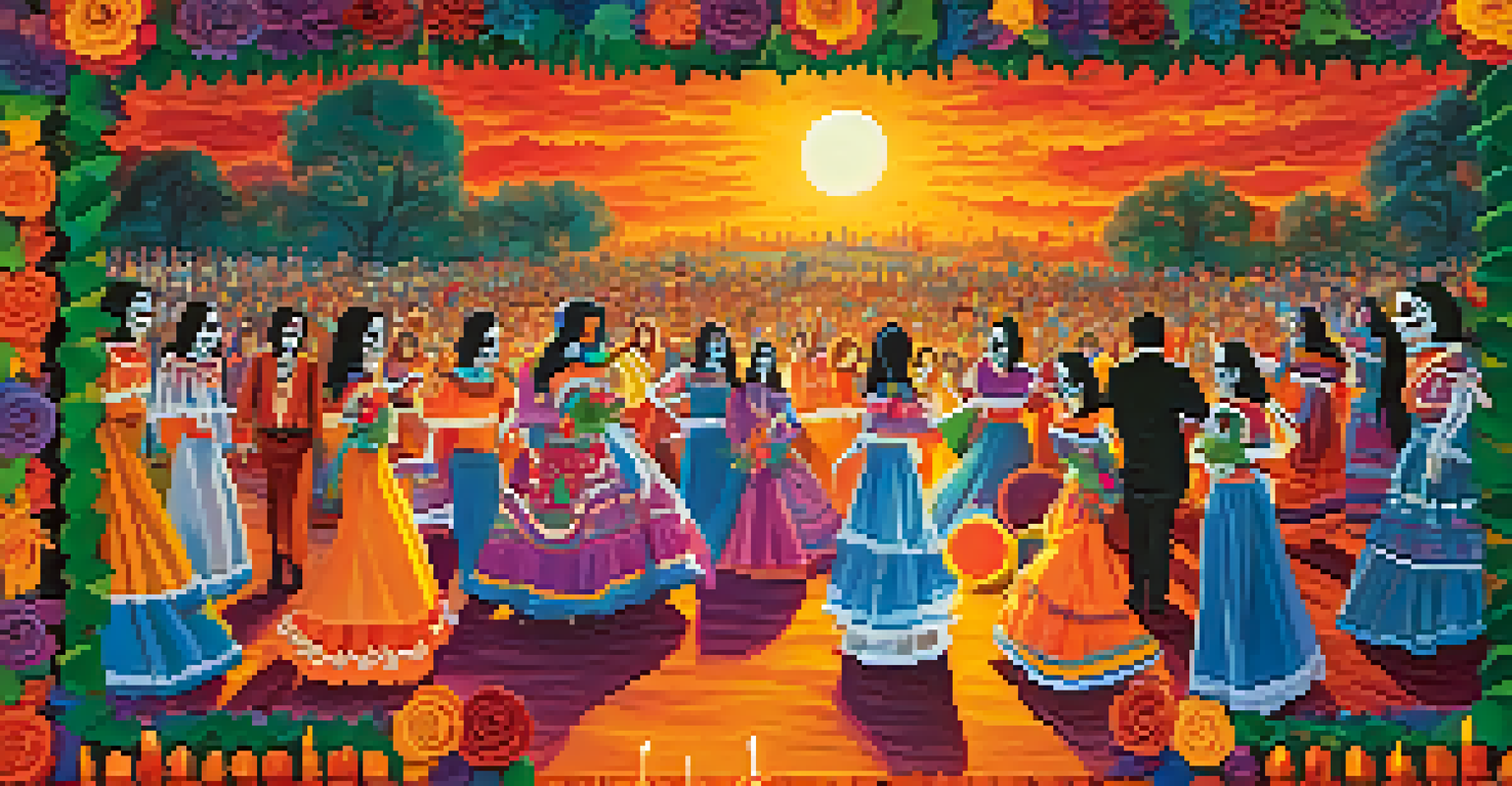La Llorona: The Weeping Woman of Austin's Riverbanks

The Origin of La Llorona's Heartbreaking Tale
La Llorona, often referred to as 'The Weeping Woman,' has deep roots in Latino folklore, particularly in Mexico. The story typically revolves around a woman who mourns her children, whom she has lost in a tragic manner. This tale has transcended borders and become a haunting legend in many Latin American cultures, symbolizing loss and despair.
Stories can be understood as a way to remember, to create a sense of identity and purpose in our lives.
In Austin, the legend takes on its own unique flavor, blending local history and the natural beauty of the riverbanks. The haunting cry of La Llorona is said to echo through the trees, drawing in curious souls who want to discover the truth behind her sorrow. This connection to the land makes the story particularly resonant for those who live in the area.
The lore of La Llorona serves not only as a ghost story but also as a cautionary tale. Parents often use her story to warn children against wandering too close to the water, reminding them of the dangers that lurk in both nature and the shadows of our fears.
La Llorona's Appearance and Symbolism
Described as a beautiful woman in a flowing white dress, La Llorona embodies both allure and sorrow. Her appearance is often accompanied by tears streaming down her face, reflecting her endless grief. This striking image makes her a compelling figure in folklore, captivating the imagination of those who hear her story.

In many interpretations, La Llorona symbolizes the pain of lost motherhood, with her cries echoing the anguish of separation from her children. This theme resonates deeply within families, serving as a reminder of the bonds we share and the heartache that can arise from loss. Her image prompts reflection on love, regret, and the consequences of our actions.
La Llorona: A Tale of Loss
La Llorona's story serves as a poignant reminder of the grief associated with lost motherhood and the universal pain of separation.
The legend also serves as a metaphor for the struggles many face in their lives. La Llorona’s endless weeping reminds us of the universal human experience of grief, loss, and longing, making her story both personal and collective. It’s a tale that transcends time and culture, resonating with anyone who has faced sorrow.
Austin's Riverbanks: The Perfect Setting for a Legend
Austin's picturesque riverbanks provide a captivating backdrop for the story of La Llorona. The lush greenery, flowing water, and tranquil environment contrast sharply with the haunting cries attributed to her legend. This juxtaposition creates an eerie atmosphere that draws both locals and visitors to explore the area and its stories.
The stories we tell ourselves shape our reality, and La Llorona is a perfect example of a narrative that reflects our deepest fears and sorrows.
Many people recount their own experiences of feeling a chill in the air or hearing whispers while walking along the riverbanks at dusk. These encounters only add to the mystique surrounding La Llorona, making the legend a topic of conversation among those who frequent the area. It’s not uncommon to hear tales of friends who dared each other to venture closer to the riverside after dark.
The natural beauty of Austin's landscape serves as a canvas for the legend, allowing it to thrive. The combination of water, trees, and folklore creates a rich storytelling environment where the lines between reality and myth blur, making the riverbanks a perfect setting for La Llorona's timeless tale.
Modern Interpretations and Cultural Significance
In modern times, La Llorona has been depicted in various forms of media, from literature to film. These interpretations often explore her story from different perspectives, providing fresh insights into her character and motivations. This evolution of the tale showcases its adaptability and relevance across generations.
Culturally, La Llorona serves as a powerful symbol for many communities. She represents the struggles faced by women, particularly in the context of motherhood and societal expectations. This connection fosters a sense of solidarity among those who relate to her pain, turning her story into a source of empowerment rather than just a cautionary tale.
Austin's Riverbanks Enrich the Legend
The picturesque riverbanks of Austin provide a hauntingly beautiful backdrop for La Llorona, enhancing the legend's allure for locals and visitors.
Additionally, the resurgence of interest in folklore has led to a renewed appreciation for stories like La Llorona's. Events and gatherings focused on storytelling help keep her legend alive, bridging generations and cultures. This ongoing dialogue emphasizes the importance of remembering our histories and the lessons they carry.
La Llorona in Local Festivals and Celebrations
In Austin, local festivals often embrace the legend of La Llorona, incorporating her story into celebrations like Día de los Muertos. This vibrant event honors loved ones who have passed, creating a space for remembrance and reflection. La Llorona’s presence in these festivities highlights the interconnectedness of grief and celebration in many cultures.
During these events, you may encounter performances that depict La Llorona’s tale, complete with music, dance, and storytelling. These artistic expressions serve to educate audiences about her legend while also allowing for a communal experience of mourning and joy. It’s a powerful reminder that our stories can be both haunting and beautiful.
The inclusion of La Llorona in local celebrations fosters a sense of community, uniting people through shared experiences. It encourages dialogue and understanding about the complexities of loss, making her story a vital part of Austin's cultural fabric. Each year, as the festivities unfold, La Llorona continues to weave her way into the hearts and minds of those who gather.
Exploring La Llorona's Legacy in Austin Today
Today, La Llorona remains a topic of fascination for both locals and tourists alike. Many people visit the riverbanks, hoping to catch a glimpse of her or hear her mournful cries. This ongoing intrigue speaks to the power of storytelling and the ways in which legends can shape our understanding of place and identity.
Local guides often share the tale with visitors, blending history with folklore to create an engaging experience. These stories not only entertain but also educate people about the cultural significance of La Llorona in Austin. This connection to the past allows for a deeper appreciation of the landscape and its stories.
Cultural Significance of La Llorona
La Llorona's presence in local festivals and storytelling events fosters community connection and highlights the complexities of grief and celebration.
As new generations emerge, the legend of La Llorona continues to evolve, ensuring her place in the tapestry of Austin's cultural narrative. Whether through folklore, art, or community events, her legacy will linger, reminding us of the richness of our shared human experience.
Conclusion: The Enduring Allure of La Llorona
The story of La Llorona is more than just a ghost tale; it’s a reflection of our shared fears and the universal experience of loss. Her haunting cries resonate deeply with the human condition, reminding us that grief is a part of life. This enduring allure keeps her story alive, captivating the imaginations of those who hear it.
As we explore the riverside and listen for her whispers, we connect with the past and embrace the complexities of our emotions. La Llorona serves as a reminder of the fragility of life and the bonds we hold dear. In this way, her legend is a treasure trove of lessons about love, loss, and the power of storytelling.

Ultimately, La Llorona's tale invites us to reflect on our own lives and the stories we carry. As we navigate the waters of our experiences, we find that, like La Llorona, we all have our own stories of sorrow and hope to share.